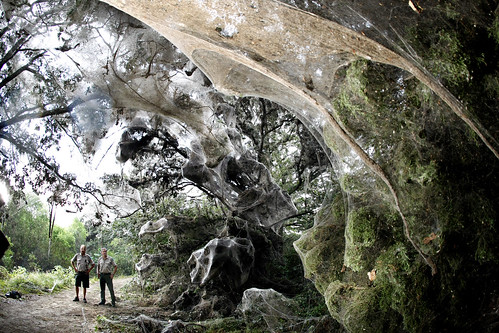tags: spider, giant spider web,arachnid, social behavior
Lake Tawokoni State Park rangers (l-r) Mike McCord and Freddie Gowin continue to monitor a giant communal spider web at the park Tuesday, August 29, 2007. Officials at Lake Tawokoni State Park have been watching the growth of a giant communal spider web that has formed in the park over the past several weeks. The giant spider webs are rare for Texas.
Image: Tom Pennington. [Scary wallpaper size]
Have you heard about the spiders that spun a web that is the size of Texas? Well, actually, the web is only the size of two football fields, but nonetheless, the millions of busy spiders and their amazing outsized construction both reside in Texas.
The web, which is deemed a "once in a lifetime occurrence" by some observers, blankets trees and shrubs in Lake Tawakoni State Park, covering 180m (650ft). However, John Jackman, a professor and extension entomologist for Texas A&M University and author of A Field Guide to the Spiders and Scorpions of Texas, was unimpressed, saying that he receives similar reports every couple of years.
"There are a lot of folks that don't realize spiders do that," Jackman observed.
However, Allen Dean, a spider expert at Texas A&M University, and several other scientists said they had never seen a web this large outside of the tropics, where there are a few species of "social" spiders that build large communal webs.
Fortunately, this giant web has also been busy capturing millions of "Texas state birds"; mosquitos.
"At first, it was so white it looked like fairyland," said Donna Garde, superintendent at the park thaty is located about 45 miles east of Dallas. "Now it's filled with so many mosquitoes that it's turned a little brown. There are times you can literally hear the screech of millions of mosquitoes caught in those webs."
Not only does the web emit a weird buzzing sound, but it smells quite bad, likely due to the dead insects entwined in the silk.
Spider silk is comprised of polymerized proteins that form a fiber that often stronger than steel of the same diameter. It is comprised of different amounts of several protein types, depending upon its intended function. Besides building webs, spiders commonly use silk to construct egg sacs, wrap up prey, as a life line, for transferring semen, as drag lines to monitor web vibrations, to fly, and for shelter. Not all species spin webs, but all spiders do construct an egg cocoon made of silk.
Silk is produced by spinneret glands that are located on the spider's abdomen, usually in pairs. The number of spinnerets varies between one and four pairs in most spider species. Different species of spiders spin webs with characteristic shapes and sizes, and they often can be identified simply by looking at the structure of the web itself. These Texas spiders have not yet been identified, however.
"Until we get some samples sent to us we really won't know what species of spider we're talking about," said Jackman.
The giant web will probably last until autumn, when the spiders will start dying.
Source
SeattleTimes (quotes).
StarTribune (quotes).


Texas is full of natural wonders, Grrl Scientist. So come on down and pay us a visit.
Hi!
I wonder if the spiders are responding to an unusually large number of mosquitos...is the number of mosquitos this year larger than normal for the region?
Very cool!
Clapping
Chardyspal
That web is amazing! I wonder how big the spiders are that made it??
Hi see this wonderfull spider
Indeed, Texas is the land where you're gonna be amazed by something, no matter what.